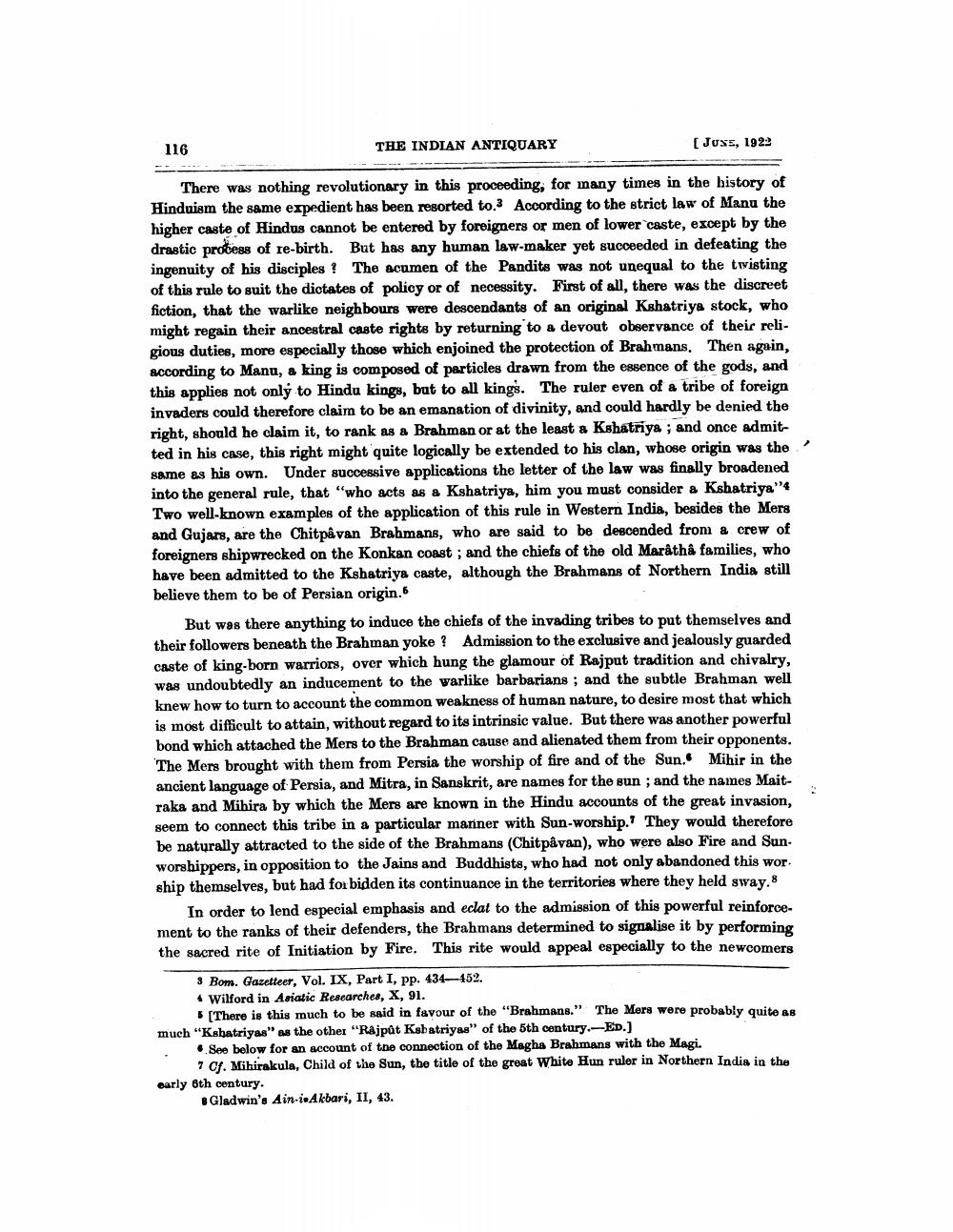________________
116
THE INDIAN ANTIQUARY
[Juss, 1922
There was nothing revolutionary in this proceeding, for many times in the history of Hinduism the same expedient has been resorted to. According to the strict law of Manu the higher caste of Hindus cannot be entered by foreigners or men of lower caste, except by the drastic process of re-birth. But has any human law-maker yet succeeded in defeating the ingenuity of his disciples ! The acumen of the Pandits was not unequal to the twisting of this rule to suit the dictates of policy or of necessity. First of all, there was the discreet fiction, that the warlike neighbours were descendants of an original Kshatriya stock, who might regain their ancestral caste rights by returning to a devout observance of their religious duties, more especially those which enjoined the protection of Brahmans. Then again, according to Manu, a king is composed of particles drawn from the essence of the gods, and this applies not only to Hindu kings, but to all kings. The ruler even of a tribe of foreign invaders could therefore claim to be an emanation of divinity, and could hardly be denied the right, should he claim it, to rank as a Brahman or at the least a Kshatriya ; and once admitted in his case, this right might quite logically be extended to his clan, whose origin was the same as his own. Under successive applications the letter of the law was finally broadened into the general rule, that "who acts as a Kshatriya, him you must consider & Kshatriya"4 Two well-known examples of the application of this rule in Western India, besides the Mers and Gujars, are the Chitpå van Brahmans, who are said to be descended from a crew of foreigners shipwrecked on the Konkan coast ; and the chiefs of the old Marathå families, who have been admitted to the Kshatriya caste, although the Brahmans of Northern India still believe them to be of Persian origin.6
But was there anything to induce the chiefs of the invading tribes to put themselves and their followers beneath the Brahman yoke ? Admission to the exclusive and jealously guarded caste of king-born warriors, over which hung the glamour of Rajput tradition and chivalry. was undoubtedly an inducement to the warlike barbarians; and the subtle Brahman well knew how to turn to account the common weakness of human nature, to desire most that which is most difficult to attain, without regard to its intrinsic value. But there was another powerful bond which attached the Mers to the Brahman cause and alienated them from their opponents. The Mers brought with them from Persia the worship of fire and of the Sun. Mihir in the ancient language of Persia, and Mitra, in Sanskrit, are names for the sun ; and the names Maitraka and Mihira by which the Mers are known in the Hindu accounts of the great invasion, seem to connect this tribe in a particular manner with Sun-worship. They would therefore be naturally attracted to the side of the Brahmans (Chitpavan), who were also Fire and Sun. worshippers, in opposition to the Jains and Buddhists, who had not only abandoned this wor ship themselves, but had forbidden its continuance in the territories where they held sway. 8
In order to lend especial emphasis and eclat to the admission of this powerful reinforcement to the ranks of their defenders, the Brahmans determined to signalise it by performing the sacred rite of Initiation by Fire. This rite would appeal especially to the newcomers
3 Bom. Gazetteer, Vol. IX, Part I, pp. 434-152. 4 Wilford in Asiatic Researches, X, 91.
5 [There is this much to be said in favour of the "Brahmans." The Mers were probably quite as much "Kshatriyas" as the other "Rajpût Kshatriyas" of the 5th century.ED.)
• See below for an account of the connection of the Magha Brahmans with the Magi.
7 Cf. Mihirakula, Child of the Sun, the title of the great White Hun ruler in Northern India in the early 6th century.
Gladwin's Ain-i-Akbari, II, 43.




